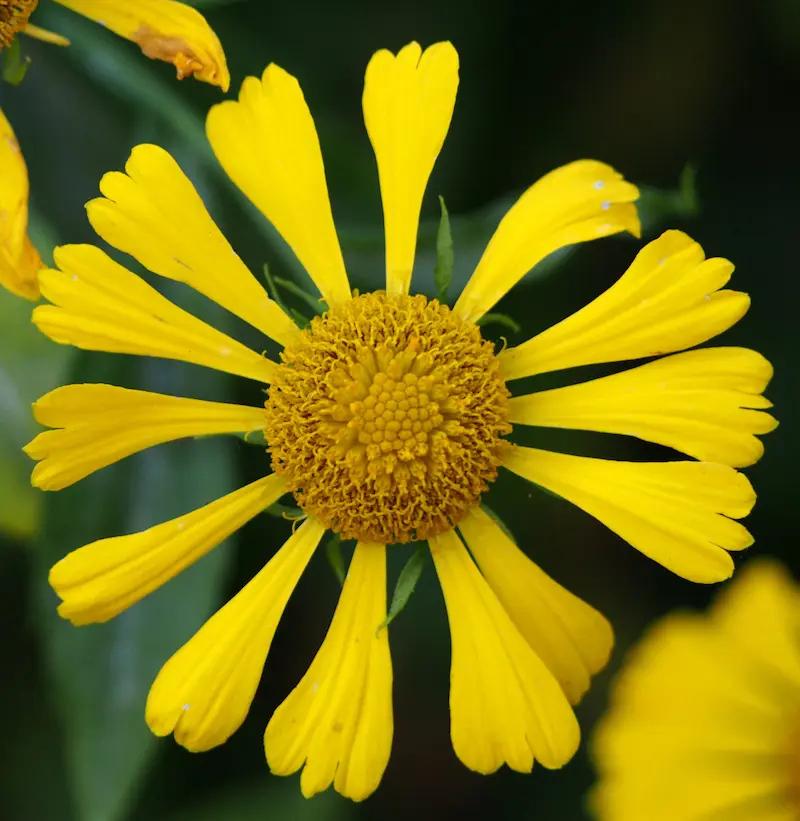Your cart is currently empty!
Mixing it Up: Combining Edibles with Ornamentals
Explore the trend of mixing ornamental and vegetable plants for striking combinations in your garden.
Your cart is currently empty!
Common Sneezeweed looks gorgeous when planted en masse and mixes wonderfully with decorative grasses or other perennial plants. It has daisy-like blooms that often attract bees and butterflies. Their blooms have characteristic wedge-shaped, brilliant yellow rays and conspicuous, dome-like, yellow centre discs. The three-lobed petals of all sneezeweeds differentiate them from Rudbeckia and other yellow coneflowers. They yield rust-colored fruits in the autumn. It’s ideal for cut flowers and butterfly gardeners.
They are widely known as ‘Sneezeweed’ because its dried leaves were once used to make snuff, which was breathed to aid with sneezing and to rid the body of bad spirits.
Botanical Name: Helenium autumnale
En français: Hélénie automnale
See More Plants in this Botanical Family:
Colour:
Sun / Shade:
Water: Twice weekly once established
Soil:
Height:
Pollinators:
Care:

The most common visitors to the flowers are long-tongued bees. Other visitors include sweat bees, wasps, flies, butterflies, and beetles. Most of these insects suck nectar, although some bees also collect pollen, and some beetles feed on the pollen.
In addtion to decorative grasses, include common sneezeweed in your pollinator garden with great blue lobelia, verbena, wild bergamot and more.
Flowers bloom from late summer through autumn (sometimes until the first frost) and can bring pleasant colour in late summer and fall when many other flowers have faded. Helenium autumnale thrives in perennial borders, grasslands and meadows, and around ponds and streams.
Although not required, plants may be cut back in early June (at least six weeks before normal flowering) to reduce plant height and to encourage branching, thus leading to a more floriferous bloom, healthier foliage and less need for support. Deadheading will extend the flowering season. Once flowering has ceased and the plant has died back the stems should be cut down.
Though they are deer resistant, common sneezeweed leaves, flowers, and seeds are poisonous to humans if eaten in large quantities, causing gastric and intestinal irritation. (Maybe deer know that!)
Despite its common name, Common Sneezeweed presents no problems for most allergy sufferers. Its pollen is distributed by insects, not wind. The common name is based on the former use of its dried leaves in making snuff, inhaled to cause sneezing that would supposedly rid the body of evil spirits.
[…] Attracting pollinators to your garden is aesthetically pleasing and has numerous benefits. Pollinators play a crucial role in plant reproduction, as they help transfer pollen from the male parts of a flower to the female parts, allowing the plants to produce seeds and fruits. […]
Explore the trend of mixing ornamental and vegetable plants for striking combinations in your garden.
Protect your family and pets from dangerous plants. Learn the names of poisonous plants and take necessary safety steps to prevent accidental poisoning.
from Old Ottawa South Garden Club Join the Old Ottawa South Garden Club for a workshop on Ikebana—a traditional Japanese art of flower arrangement by Elizabeth Armstrong, Second Associate Master in the Ohara School. Learn about its history and create your own arrangement with help from Elizabeth and Patty McGaughlin. Next meeting on April 9th to learn about easy-care, hardy perennials and lazier gardener methods.
Burdock long tap roots haven’t developed the little hair-like roots that anchor them in the ground. I get great joy in pulling noxious weeds.
Learn how to create a stunning pond with carefully planted bog plants and trimmed bullrushes, while also managing garden compromises and tackling goutweed infestation.
As the warmer weather rolls in, it’s time to think about doing a spring clean-up, to make sure that the yard and landscape are looking good.
GardeningCalendar.ca gets some funding from advertisers. If you click on links and advertisements at no cost to you, the site may receive a small commission that helps fund its operation.
© 2025 J&S Calendars Ltd.
Leave a Reply
You must be logged in to post a comment.